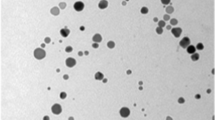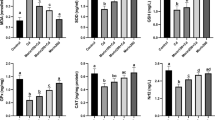Abstract
Cadmium (Cd), an environmental contaminant with a wide range of harmful effects, causes hepatotoxicity by inducing oxidative stress in liver cells. Crassocephalum rubens synthesized gold nanoparticles (CR-AuNPs) has strong antioxidant capacity with the potential to mitigate the Cd-induced oxidative injury. This study investigated the capability of CR-AuNPs in attenuating Cd-induced hepatotoxicity in rats. Hepatotoxicity was induced by daily oral administration of CdCl2 (20 mg/kg) to rats for 5 days. Thereafter, a hepatoprotective drug (silymarin, 10 mg/kg) and CR-AuNPs (5 and 10 mg/kg) were orally given daily to the intoxicated rats for 14 days. Biomarkers of hepatotoxicity (serum albumin, ALT, AST, liver arginase, SOD and MDA levels, and mRNA expressions of GGT and TNF) were determined to assess treatment effects. Administration of CdCl2 resulted in significant (p < 0.05) elevation in levels of hepatic biomarkers (ALT and AST), liver arginase, and malondialdehyde, as well as upregulation in mRNA expression of γ-glutamyl transferase (GGT) and tumor necrosis factor-α (TNF-α) genes in comparison with control group. Treatment of Cd administered rats with CR-AuNPs for 14 days attenuated these changes, as evidenced by significant (p < 0.05) reduction in the levels of these parameters and significant elevation (p < 0.05) in serum albumin and liver superoxide dismutase when compared with the Cd-induced liver toxicity rats. Based on these findings, it can be concluded that CR-AuNPs (mostly at 10 mg/kg b.w.) could attenuate the Cd-induced pathological changes in rat’s liver.








Similar content being viewed by others
Availability of data and materials
Not applicable.
Abbreviations
- ALT:
-
Alanine aminotransferase
- ANOVA:
-
One-way analysis of variance
- AST:
-
Aspartate aminotransferase
- CR-AuNPs:
-
Crassocephalum rubens Synthesized gold nanoparticles
- EDX:
-
Energy dispersive X-ray
- FTIR:
-
Fourier-transform infrared
- GGT:
-
γ-Glutamyl transferase
- TNF-α:
-
Tumor necrosis factor-α
- MDA:
-
Malondialdehyde
- SOD:
-
Superoxide dismutase
- TEM:
-
Transmission electron microscopy
- SEM:
-
Scanning electron microscopy
- UV-vis:
-
Ultraviolet-visible spectroscopy
References
Adefegha SA, Omojokun OS, Oboh G (2015) Modulatory effect of protocatechuic acid on cadmium induced nephrotoxicity and hepatoxicity in rats in vivo. Springerplus 4:619
Adewale OB, Anadozie SO, Okpiri RT, Jaiyesimi KF, Owolabi OV, Akinlade O, Obafemi TO, Osukoya OA, Onasanya A (2022) Synthesized gold nanoparticles mediated by Crassocephalum rubens extract down-regulate KIM-1/NGAL genes and inhibit oxidative stress in cadmium-induced kidney damage in rats. Drug Chem Toxicol. https://doi.org/10.1080/01480545.2022.2138427:1-8
Adewale OB, Egbeyemi KA, Onwuelu JO, Potts-Johnson SS, Anadozie SO, Fadaka AO, Osukoya OA, Aluko BT, Johnson J, Obafemi TO, Onasanya A (2020) Biological synthesis of gold and silver nanoparticles using leaf extracts of Crassocephalum rubens and their comparative in vitro antioxidant activities. Heliyon 6:e05501
Arroyo VS, Flores KM, Ortiz LB, Gómez-Quiroz LE, Gutiérrez-Ruiz MC (2012) Liver and cadmium toxicity. J Drug Metab Toxicol 5
Đukić-Ćosić D, Baralić K, Javorac D, Djordjevic AB, Bulat Z (2020) An overview of molecular mechanisms in cadmium toxicity. Curr Opin Toxicol 19:56–62
Go YM, Sutliff RL, Chandler JD, Khalidur R, Kang BY, Anania FA, Orr M, Hao L, Fowler BA, Jones DP (2015) Low-dose cadmium causes metabolic and genetic dysregulation associated with fatty liver disease in mice. Toxicological Sciences : an Official Journal of the Society of Toxicology 147:524–534
Hrabák A, Bajor T, Mészáros G (2008) The inhibitory effect of various indolyl amino acid derivatives on arginase activity in macrophages. Amino Acids 34:293–300
Hussein RH, Khalifa FK (2014) The protective role of ellagitannins flavonoids pretreatment against N-nitrosodiethylamine induced-hepatocellular carcinoma. Saudi Journal of Biological Sciences 21:589–596
Jin X, Simeon NC, Palma J, Kim D, Ngabire D, Kim N-H, Tarte NH, Kim G-D (2018) Anticancer activity of Sasa borealis leaf extract-mediated gold nanoparticles AU - Patil, Maheshkumar Prakash. Artificial Cells, Nanomedicine, and Biotechnology 46:82–88
Joardar S, Dewanjee S, Bhowmick S, Dua TK, Das S, Saha A, De Feo V (2019) Rosmarinic acid attenuates cadmium-induced nephrotoxicity via inhibition of oxidative stress, apoptosis, inflammation and fibrosis. Int J Mol Sci 20:2027
Kaur G, Shivanandappa TB, Kumar M, Kushwah AS (2020) Fumaric acid protect the cadmium-induced hepatotoxicity in rats: owing to its antioxidant, anti-inflammatory action and aid in recast the liver function. Naunyn-Schmiedeb Arch Pharmacol 393:1911–1920
Lee KX, Shameli K, Yew YP, Teow SY, Jahangirian H, Rafiee-Moghaddam R, Webster TJ (2020) Recent developments in the facile bio-synthesis of gold nanoparticles (AuNPs) and their biomedical applications. Int J Nanomed 15:275–300
Misra HP, Fridovich I (1972) The role of superoxide anion in the autoxidation of epinephrine and a simple assay for superoxide dismutase. J Biol Chem 247:3170–3175
Mistry D, Stockley RA (2010) Gamma-glutamyl transferase: the silent partner? COPD: J Chronic Obstr Pulm Dis 7:285–290
Momeni HR, Eskandari N (2020) Curcumin protects the testis against cadmium-induced histopathological damages and oxidative stress in mice. Hum Exp Toxicol 39:653–661
Ohta H, Yamauchi Y, Nakakita M, Tanaka H, Asami S, Seki Y, Yoshikawa H (2000) Relationship between renal dysfunction and bone metabolism disorder in male rats after long-term oral quantitative cadmium administration. Ind Health 38:339–355
Poosa M, Vanapatla SR (2020) Protective effect of Antigonon leptopus (Hook et. Arn) in cadmium induced hepatotoxicity and nephrotoxicity in rats. Clin Phytoscience 6:32
Rambanapasi C, Zeevaart JR, Buntting H, Bester C, Kotze D, Hayeshi R, Grobler A (2016) Bioaccumulation and subchronic toxicity of 14 nm gold nanoparticles in rats. Molecules 21
Sibuyi NRS, Thipe VC, Panjtan-Amiri K, Meyer M, Katti KV (2021a) Green synthesis of gold nanoparticles using Acai berry and Elderberry extracts and investigation of their effect on prostate and pancreatic cancer cells. Nanobiomedicine 8:1849543521995310
Sibuyi NRS, Moabelo KL, Fadaka AO, Meyer S, Onani MO, Madiehe AM, Meyer M (2021b) Multifunctional gold nanoparticles for improved diagnostic and therapeutic applications: a review. Nanoscale Res Lett 16:174
Varshney R, Kale RK (1990) Effects of calmodulin antagonists on radiation-induced lipid peroxidation in microsomes. Int J Radiat Biol 58:733–743
Acknowledgements
The authors would like to acknowledge the technologists of Biochemistry Program, Afe Babalola University, Ado-Ekiti, Nigeria for technical assistance provided during the research.
Author information
Authors and Affiliations
Contributions
OBA conceptualized the idea. OBA and SOA supervised, analyzed data, and interpreted the results. JCO, OA, and AAO executed the research work under the guidance of JOA, DFA, and OTI. OBA, SOA, and OAO contributed to preparation of the manuscript. All authors approved the final manuscript.
Corresponding author
Ethics declarations
Funding
No external funding received.
Conflict of interest
The authors declare no competing interests.
Ethical approval
All animal procedures were carried out following the EU Directive 2010/63/EU for animal experiments and the Animal Research Reporting In Vivo Experiments (ARRIVE) guidelines, as well as the of Afe Babalola University’s animal ethics committee guidelines.
Informed consent
For this type of study, informed consent is not required.
Consent for publication
For this type of study, consent for publication is not required.
Additional information
Publisher's Note
Springer Nature remains neutral with regard to jurisdictional claims in published maps and institutional affiliations.
Rights and permissions
Springer Nature or its licensor (e.g. a society or other partner) holds exclusive rights to this article under a publishing agreement with the author(s) or other rightsholder(s); author self-archiving of the accepted manuscript version of this article is solely governed by the terms of such publishing agreement and applicable law.
About this article
Cite this article
Adewale, O.B., Anadozie, S.O., Odomene, J.C. et al. Attenuation of cadmium-induced hepatotoxicity by orally administered Crassocephalum rubens synthesized gold nanoparticles in rats. Comp Clin Pathol 32, 691–698 (2023). https://doi.org/10.1007/s00580-023-03477-y
Received:
Accepted:
Published:
Issue Date:
DOI: https://doi.org/10.1007/s00580-023-03477-y




